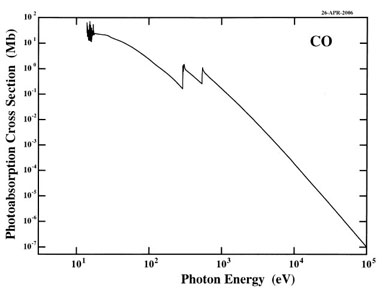
Naoki Sakamoto1, Hidetsugu Tsuchida2, Takako Kato3,
Sachie Kamakura1, Hidemi Ogawa1, Kunikazu Ishii1,
Izumi Murakami3, Daiji Kato3, Hiroyuki Sakaue3, Masatoshi Kato3,
Joseph Berkowitz4, Mitio Inokuti4
1Department of Physics, Nara Women's University, Nara 630-8506, Japan
2Quantum Science and Engineering Center, Kyoto University, Uji 611-0011, Japan
3National Institute for Fusion Science, Toki, Gifu 509-5292, Japan
4Argonne National Laboratory, Argonne, Illinois 60439, USA
published as NIFS-DATA-109 (2010)
Datasets of oscillator strength spectra, photoabsorption cross sections, and mass absorption coefficients are evaluated for 9 atoms (H, He, Li, N, O, Ne, Na, Cl, and Ar) and 23 molecules (H2, N2, O2, CO, NO, HCl, H2O, CO2, N2O, NO2, H2S, SO2, O3, NH3, CH4, C2H2, C2H4, C2H6, CH3OH, C6H6, SiH4, SF6, and C60), which are based on the data compiled by Berkowitz [Atomic and Molecular Photoabsorption: Absolute Total Cross Sections (Academic Press, 2002)]. The atomic number of adopted atoms is up to 18 (Ar) and that of constituent atoms of adopted molecules is not larger than 17 (Cl). For these atoms and molecules, experimental data are plenty to construct a reliable oscillator strength spectrum over the entire energy region. Datasets reported here are presently the most reliable because Berkowitz adopted cross sections after severe consideration of existing experimental data. The oscillator strengths are selected to satisfy the several sum rules and other theoretical bound conditions.